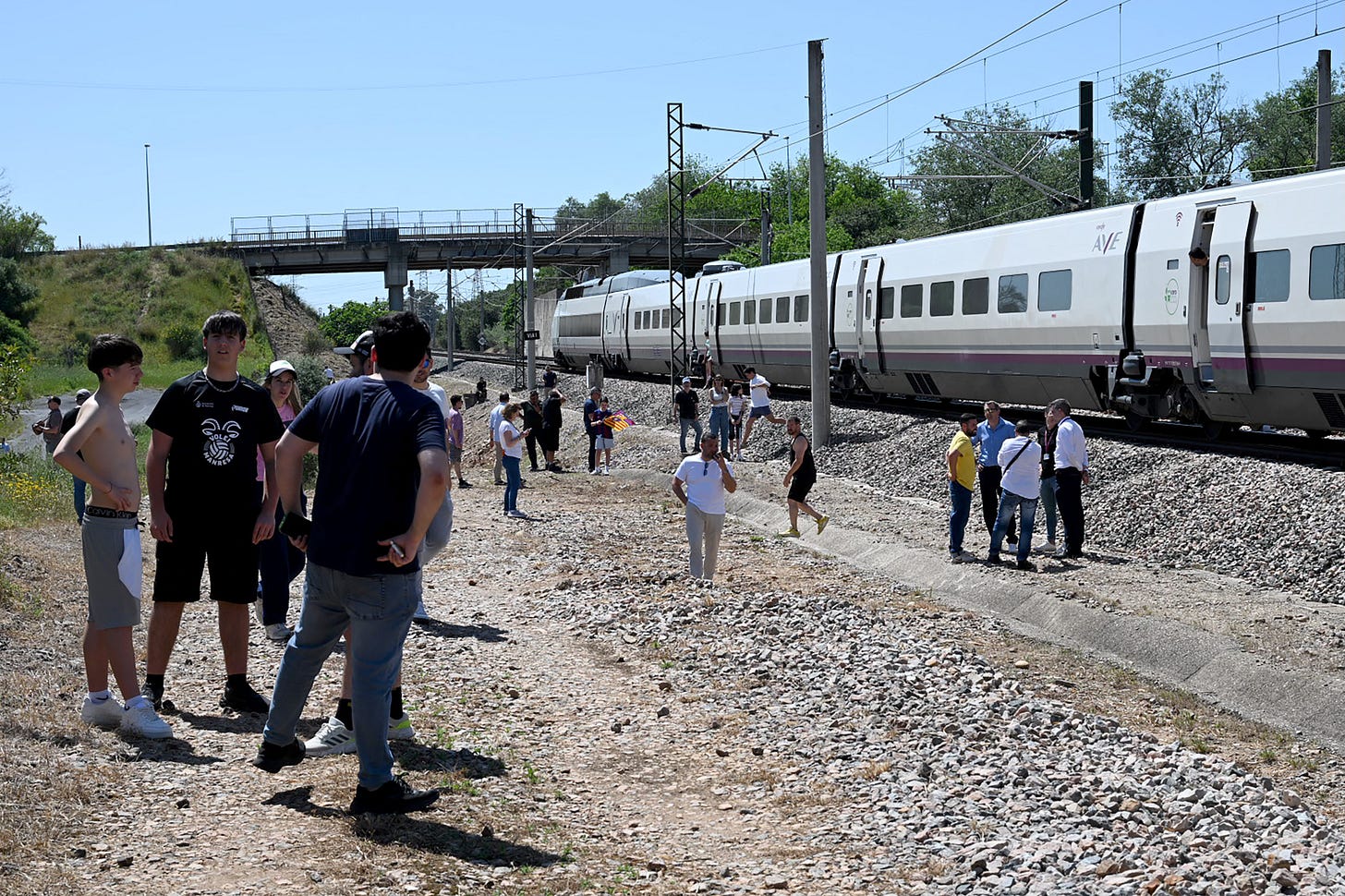Over-Reliance On Renewables Behind Catastrophic Blackouts in Spain
Excess solar resulted in too little “inertia,” making the whole system vulnerable

Six days ago, the media celebrated a significant milestone: Spain’s national grid operated entirely on renewable energy for the first time during a weekday.
At 12:35 pm today local time, the lights went out across Spain and Portugal, and parts of France. Although power was quickly restored in France, it could take a week to fully restore power in Spain and Portugal.
In an instant, the electric hum of modern life — trains, hospitals, airports, phones, traffic lights, cash registers — fell silent. Tens of millions of people instantly plunged into chaos, confusion, and darkness. People got stuck in elevators. Subways stopped between stations. Gas stations couldn’t pump fuel. Grocery stores couldn’t process payments. Air traffic controllers scrambled as systems failed and planes were diverted. In hospitals, backup generators sputtered on, but in many cases could not meet full demand. Cell towers collapsed under surges and outages.

It was one of the largest peacetime blackouts Europe has ever seen. And it was not random. It was not an unforeseeable event. It was the exact failure that many of us have been, repeatedly, warning lawmakers about for years — warnings that Europe’s political leaders systematically chose to ignore.
While Portugal’s grid operator REN initially blamed the mass blackout on “extreme temperature variations” and a “rare atmospheric phenomenon,” and while some media repeated that framing, the reality is more serious. Weather may have triggered the event, but it was not the cause of the system’s collapse.
Spain’s national grid operator, Red Eléctrica, revealed that the immediate cause of the blackout was a “very strong oscillation in the electrical network” that forced Spain’s grid to disconnect from the broader European system, leading to the collapse of the Iberian Peninsula’s power supply at 12:38 p.m.
“No one has ever attempted a black start on a grid that relies so heavily on renewables as Iberia,” noted one energy analyst on X. “The limited number of thermal generators will make it more challenging to re-establish momentum and frequency control.”
In a traditional power grid dominated by heavy spinning machines — coal plants, gas turbines, nuclear reactors — small disturbances, even from severe weather, are absorbed and smoothed out by the sheer physical inertia of the system. The heavy rotating mass of the generators acts like a shock absorber, resisting rapid changes in frequency and stabilizing the grid.
But in an electricity system dominated by solar panels, wind turbines, and inverters, there is almost no physical inertia. Solar panels produce no mechanical rotation. Most modern wind turbines are electronically decoupled from the grid and provide little stabilizing force. Inverter-based systems, which dominate modern renewable energy grids, are precise but delicate. They follow the frequency of the grid rather than resisting sudden changes.

As a result, when a disturbance hit Spain’s grid on April 28, there was too little heavy machinery to dampen the oscillations. Instead, the oscillations grew rapidly, shaking the grid apart. Protection systems tripped offline to prevent equipment damage. Plants disconnected. Regions split from one another. And within minutes, tens of millions of people were left without power across Spain and Portugal. The underlying cause of the blackout was not weather. It was the structural fragility created by heavy reliance on inverter-based renewable energy, without sufficient backup, inertia, or stabilization.
Five minutes before the blackout, at 12:30 p.m. local time, Spain’s electricity grid was running under highly unusual and dangerous conditions. Solar photovoltaic, solar thermal, and wind power together supplied about 78 percent of all generation. Nuclear provided about 11.5 percent. Co-generation, mostly industrial waste heat plants, added another 5 percent. Gas-fired plants contributed just about 3 percent — less than one gigawatt across the entire grid.
This meant that almost no dispatchable, spinning generation was online. No heavy turbines. No stabilizing momentum. Almost no inertia, the physical property that resists sudden changes in motion, and which has stabilized electrical grids for over 100 years.
As a result, when the disturbance hit at around 12:35 p.m., the system had nothing to resist it. The grid’s frequency, essentially the heartbeat of the system, instantly plunged. The disturbance didn’t just affect Spain. Grid frequency drops were registered across continental Europe.
This wasn’t just a Spanish blackout. It shook the entire European grid.

But none of this should have been a surprise. The underlying physics had been understood for years, and the specific vulnerabilities had been spelled out repeatedly in technical warnings that policymakers ignored.
For over a century, electricity grids were built around heavy, spinning machines like coal plants, gas turbines, and nuclear reactors. These machines spun massive metal shafts at thousands of revolutions per minute, creating electricity while also providing inertia, which smoothed out shocks to the grid and gave operators time to respond to faults. It was free and automatic.
The rise of solar and wind changed that. Solar panels do not spin heavy turbines. Wind turbines, while they do spin, are usually electronically decoupled from the grid and do not provide direct mechanical inertia. Both rely on inverters — electronics that convert direct current (DC) from the source into alternating current (AC) for the grid. Inverters are fast, efficient, and precise, but they have no mass, no stored momentum, and therefore no ability to stabilize the system when it wobbles. Inverters follow the grid’s frequency, but they do not resist changes.
As countries replaced heavy, spinning plants with lightweight, inverter-based generation, the grid became faster, lighter, and far more sensitive to disruptions. That basic physical reality was spelled out in public warnings as far back as 2017.
In 2017, ENTSO-E, the European Network of Transmission System Operators for Electricity, published a major report warning that rising levels of inverter-based generation would cause frequency deviations to grow larger and faster after disturbances. ENTSO-E concluded that the risk of cascading failures across Europe would increase unless governments invested heavily in synthetic inertia, large-scale storage, and smarter real-time grid management.

In 2022, a team of researchers modeled the Spanish grid with large use of wind and solar and warned that, without significant investments in flexibility and inertia-providing technologies, the grid’s stability would be at risk. The authors show that as coal, nuclear, and combined-cycle plants are phased out, curtailment of wind and solar will rise dramatically, and grid inertia would fall, increasing the likelihood of frequency instability. They concluded that to maintain reliability alongside decarbonization goals, Spain must build substantial new sources of synthetic inertia, backup generation, and grid flexibility .
Other countries were seeing the same risks play out in real time. After a massive blackout in South Australia in September 2016, where a combination of high renewable penetration and a major storm led to a grid collapse, Australian investigators concluded that the lack of inertia was a key reason the system could not recover.
Germany faced a near-blackout in 2017 after a frequency deviation, and avoided collapse only through emergency imports from France and Poland.
Britain suffered a major blackout in August 2019 after a lightning strike combined with low inertia conditions, cutting power to nearly a million people.
Spain’s government began phasing out its nuclear plants following a 2019 decision to close all reactors by 2035, part of its Integrated National Energy and Climate Plan. Over the past five years, Spain has forced its utilities to take steps to close its nuclear plants without replacement, even as solar and wind installations surged.
Although political leaders promised that renewable energy would provide stable, affordable power, in practice, Spain grew more reliant on the remaining nuclear and natural gas plants to sustain inertia — even as the government pushes them to close.
Meanwhile, new vulnerabilities were appearing that went beyond physics. Cybersecurity researchers this year identified dozens of critical security flaws in solar inverter systems produced by major manufacturers including SMA, Growatt, and Sungrow. These vulnerabilities, which could allow hackers to remotely alter settings, disable systems, or coordinate attacks.

Solar panels had quietly become part of the Internet of Things — millions of them, lightly defended, networked, and exposed. The energy system is now vulnerable not just to storms or accidents but also to remote manipulation.
Despite all these warnings, political and regulatory energy in Europe remained focused on accelerating renewable deployment, not upgrading the grid’s basic stability. In Spain, solar generation continued to climb rapidly through 2023 and early 2024. Coal plants closed. Nuclear units retired. On many spring days by 2025, Spain’s midday solar generation exceeded its total afternoon demand, leading to frequent negative electricity prices
The system was being pushed to the limit.
And today, at 12:35 pm, it broke.
When the disturbance occurred, Spain’s grid, running mostly on solar, wind, and a handful of nuclear plants, could not absorb the hit. With so little inertia online, frequency plummeted. Protection systems kicked in automatically, disconnecting plants to prevent equipment damage. Disconnections triggered more instability, causing more plants to trip offline in a vicious cycle. Within minutes, the entire Spanish and Portuguese grids collapsed.
Spain’s blackout wasn’t just a technical failure. It was a political and strategic failure.
It was the predictable result of ignoring clear, repeated warnings about how fragile the modern grid was becoming.
People will rightly note that things could have been done to prevent this, but the underlying point remains: large quantities of renewables make the grid unstable, potentially catastrophically so.
As for the claim that Spain received 100% of its electricity, that turns out to also not be true: nuclear plants and some natural gas plants were still running and supplying all-important dispatchable power and inertia, noted Mark Nelson of Radiant Energy Group.
The planned closure of remaining nuclear reactors will further reduce the grid’s ability to maintain stability under stress. Unlike renewables, nuclear plants provide steady, dispatchable power and contribute critical, inherent inertia to the electrical system, helping to resist and absorb disturbances.
Without that stabilizing force, Spain’s grid will depend increasingly on lightweight, inverter-based generation that cannot resist sudden oscillations. Unless Spain rapidly invests in synthetic inertia, maintains and expands its nuclear fleet, or adds some other new form of heavy rotating generation, the risk of future blackouts will only grow worse.
We are a group of about 200 ordinary citizens who mostly live near Atlantic City, New Jersey. We volunteer our time and money to maintain this website. We do our best to post accurate information. However, we admit we make mistakes from time to time. If you see any mistakes or inaccurate, misleading, outdated, or incomplete information in this or any of our posts, please let us know. We will do our best to correct the problem as soon as possible. Thanks.
Seth Grossman, Executive Director
LibertyAndProsperity.com


What is probability that USA could have regional blackouts due to rapid introduction of solar and wind power into regional grids in California for example ? Mid Atlantic states PMJ grid ?
I believe Germany about 10 years ago at least made a national “ green “ decision to completely eliminate Nuclear Power ? Is Germany at risk today to Blackouts covering all of Germany and its Industry? Joel
Please read our new post on “El Blackout”, the failure of wind and solar electric power last week in Spain and Portugal.